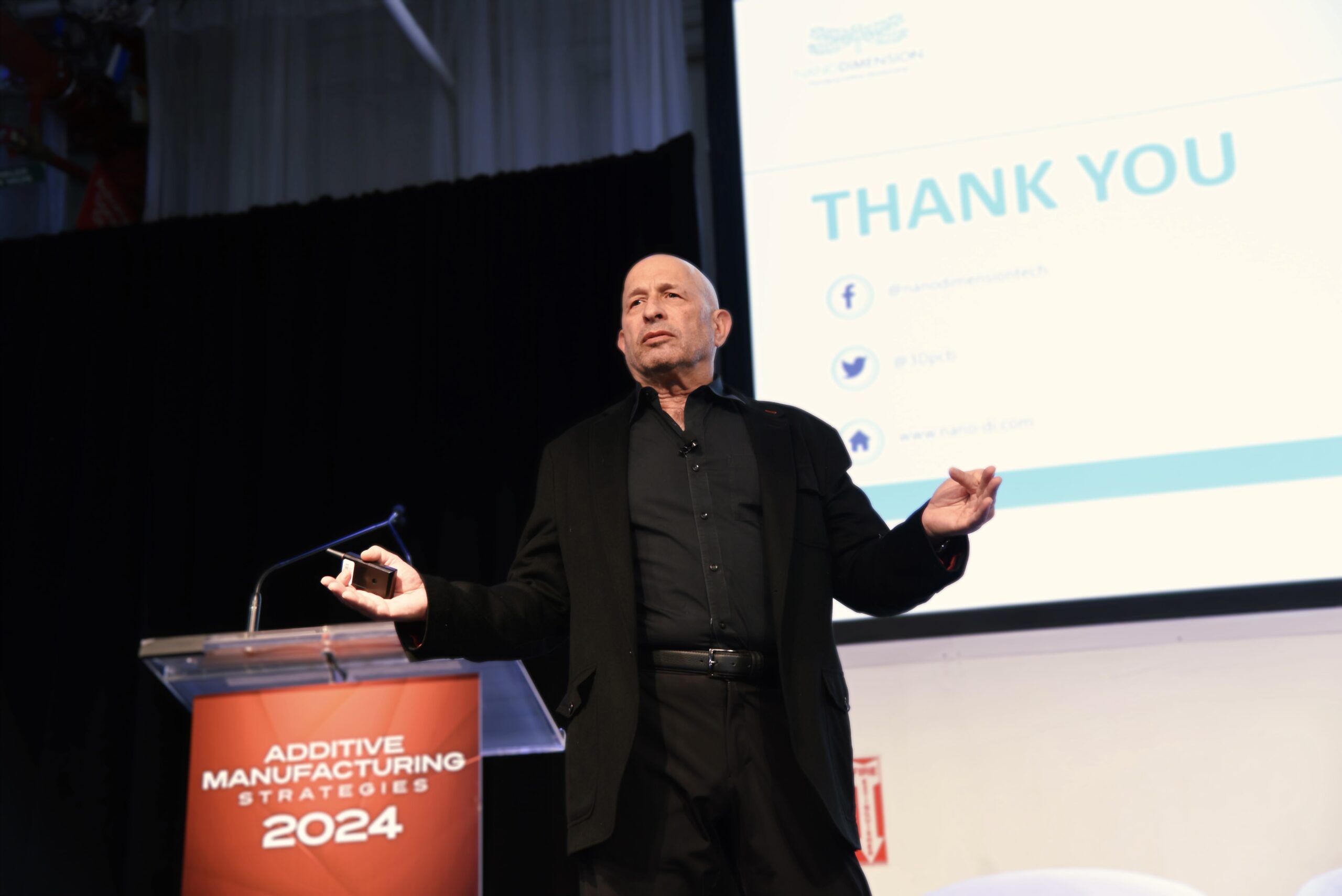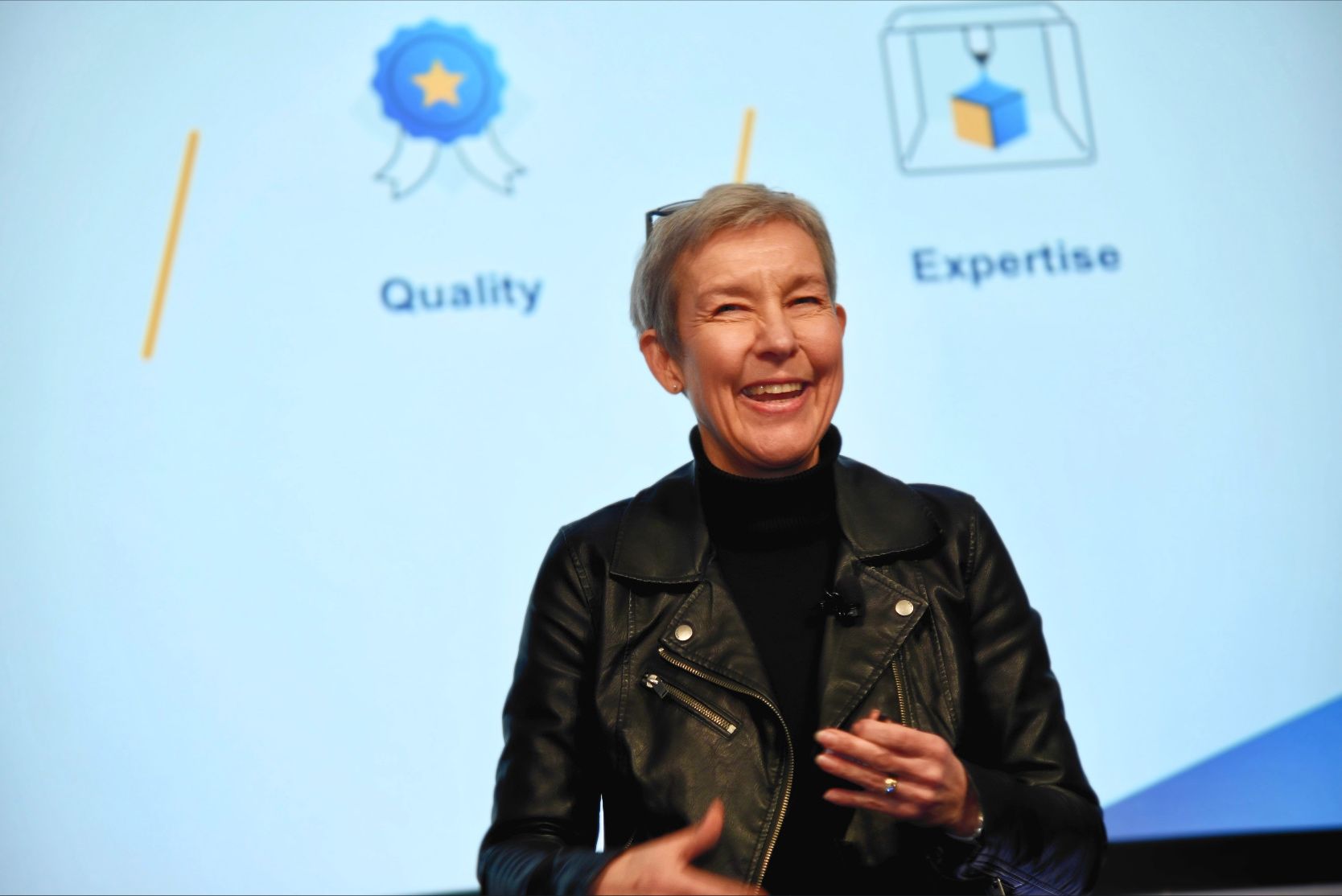One of the defining features of the Additive Manufacturing Strategies (AMS) business summit has been its emphasis on the financial aspects of the 3D printing market. That was no different from this year’s event. However, while a large topic of discussion was the stagnation of investment into startups and poor performance of public additive manufacturing (AM) firms, there was a potentially more important theme that was central to the next stage of development of the industry.
In a way, the word “collaboration” is both vague and fluffy. Nonetheless, it was a recurring topic and one with which some initiatives have demonstrated real, tangible success.
The Multiple Yoavs
On days one and two of AMS, there was a palpable energy in the air related to the ongoing conflict between Stratasys (Nasdaq: SSYS) and Nano Dimension (Nasdaq: NNDM). This was due to the fact that the CEOs of both companies, Yoav Zeif and Yoav Stern, gave keynote addresses. Their talks emphasized the state of the industry and publicly traded stocks, with Stratasys’s Zeif indicating the way his firm will advance and grow, with the ultimate outcome being consolidation.

Yoav Zeif, CEO of Stratasys, at Additive Manufacturing Strategies 2024 alongside 3DPrint.com Executive Editor Joris Peels. Image courtesy of Ashley Alleyne.
“Consolidation is a must and scale is a must in order to be able to deliver the expectation and the value to our customers,” Zeif said. “Look at other industries. The five top players in construction represent 44% of the industry, the four top players are 64% in cloud, in agriculture 60% of the market is led by the top four players. In our industry, the top five leaders are 29% of the market. The next five are an additional 10%. The mid-tier, $20 to $100 million dollar, another 10%. And all of the others, hundreds of companies [under $20 million] are the other 51%. It is great. It is not sustainable. So, we need to join forces. This is a hypothesis, but I believe that we have not been properly facing the reality that we need to consolidate and to be like other industries… Otherwise, we not cross the cross the chasm because we do not have the resources.”

Yoav Stern, CEO of Nano Dimension, at Additive Manufacturing Strategies 2024. Image courtesy of Ashley Alleyne.
Stern, meanwhile, took jabs at fellow AM companies and called for profitability.
“We are in supply chains where manufacturing of things cannot be manufactured differently. So, we will be there, but many of us will not because you cannot build an industry after 20 to 25 years without being profitable,” Stern said. “Look at the public companies without naming names. One of them is showing every quarter some profit up and down and $100 million in revenue. Guys, profitability is not a game of adjusted non-GAAP profits. Profitability is positive cash flow.”
And, like the other Yoav, Stern ultimately called for consolidation:
“So, what I’m trying to tell you—the bottom line of my message to you is: get over your egos. You are not worth billions. You are worth what you are worth. And consolidate, put yourselves together.”
The merging of businesses was a forgone conclusion for these companies as a means of scaling up the technology to address the needs of their manufacturing customers. Outside of the public firms, the mood and path forward were very different. Despite a slowed investment environment, multiple startup founders seemed anything but discouraged. Nor did they think consolidation was necessary for scaling.
One CEO mentioned refining their business strategy such that they believed they would achieve profitability by the end of the year. Another noted how, by combining government grants with matching investments from the private sector, they had found a perfect means of blending the interests of both parties to grow. Yet another is looking very closely at the numerous government calls for advanced manufacturing partners to solve part shortages to tap into federal funding.
“Maybe they are struggling with poor financial performance,” one startup founder said. “But they can’t speak for the rest of the industry. Anyone who thinks that 3D printing is dead has no idea what they’re talking about.”
Collaboration
There was an executive from a publicly-traded company that didn’t necessarily see a need for consolidation. Stepping into the role left by Fried Vancrean, Materialise (Nasdaq: MTLS) CEO Brigitte de Vet-Veithen gave an inspiring keynote calling for collaboration. Likening the software model of her company to Salesforce, she envisions Materialise as developing what is essentially an operating system for 3D printers to which third-party modules can be added. That is exactly what the firm’s CO-AM platform does, creating a larger collaborative ecosystem that links multiple vendors together.
“Our industry cannot afford to maintain hundreds of these different platforms and ecosystems. The industry is simply too small for that. And if we look at how that happened in other industries, we’ve seen exactly the same,” de Vet-Veithen said. “Take the example of the CRM software that helps companies interface with our customers and develop intelligence on our customers. Salesforce is the platform in that market. We don’t have 50 different platforms. There may be one or the other option that you have to choose, but Salesforce really is the standard. But Salesforce is also a very open platform because it allows third-party apps to be on that platform. It even allows for further development through their SDK on their platform. And that’s how that industry, which didn’t exist and was as tiny as we are today in the beginning, became a massive industry. Honestly, I think we need exactly the same.”

Materialise CEO Brigitte de Vet-Veithen at Additive Manufacturing Strategies 2024. Image courtesy of Ashley Alleyne.
Though CO-AM is a software solution to enable collaboration, other panels boasted a much more traditional approach: the consortium. Pioneering the technique in the AM industry, Mobility Goes Additive (MGA) brought together over 150 stakeholders to develop standards related to 3D printing in the rail sector before ultimately enabling the production of parts to those standards. Though MGA was initiated by German rail group Deutsche Bahn—which has now 3D printed over 120,000 components in total—multiple rail companies are now involved and benefitting from the consortium. It has been so successful that MGA has ported the model over to the medical sector.
There was no doubt that panelists speaking alongside MGA Managing Director Stefanie Brickwede were envious of the model and looking to pursue parallel efforts in their sectors. For instance, Matthew Sermon, Executive Director for Program Executive Office for Strategic Submarines at the U.S. Navy, practically begged for such an endeavor to support the Navy and went so far as to invite co-speaker Mario Dimovski, Director of Innovation and Transformation at the Boyd Group and a member of the 3D Printing in Auto Repair Task Force, to reach out to him for aid in accelerating the adoption of 3D printing in the auto industry.
“The Navy is not quite at 120,000 parts yet. I’m pretty jealous. Our approach is a consortium-style one. Quite simply, scaling additive manufacturing, especially metallic for submarines, right now is a national security imperative… With a broad consortium of academia, applied research institutions, and companies that are leading the way,” Sermon said. “What I go around doing every day is—using the simple fact that we have to deliver submarines and my portfolio on time as a foundation of national security strategy—inspire increased agility and partnerships… I believe that from a national security perspective, this is our Manhattan Project: scaling additive and other advanced manufacturing as quickly as we possibly can.”
The concept of a Manhattan Project for reshoring and advanced manufacturing is one that 3DPrint.com Macro Analyst Matt Kremenetsky has been pushing for some time. The other panelists seemed to be on board. Dimovski followed on:
“The Automotive Task Force is a great example [of collaboration]. It comprised a dozen experts from around the world, each specializing in a different aspect of the 3D printing supply chain, from printing to supplies, including collision experts, materials experts, and salvage experts. They all came together and contributed to delivering an amazing white paper. What the Task Force report revealed four months later is that we have some amazing opportunities but also face some challenges. None of this would have been possible without everyone collaborating together. Even from a trade perspective, like many other trades, we have skills. Businesses want to focus on what they’re great at; they can’t be everything to everyone. We want to focus on repairing cars and collaborate with printing companies, HP, material providers, and other providers. So, I think in today’s world, collaboration is key.”
Later that day, representatives from the oil and gas sector called for similar efforts. In order for AM companies to understand the needs of oil majors, the sharing of information is essential. This includes everything from standards to material and process data that can be used to prove to companies that they can 3D print parts for oil and gas.
“The oil and gas industry, the aerospace and defense industry, everybody is working on this same capability,” said Roxanne Warren, Managing Director of Supplier Networks at BlueForge Alliance. “From a consortium perspective, from a technology perspective, from an experience or lessons learned perspective—even Paul Gradl in the previous presentation talked about how NASA’s been working on this—let’s all figure out how to share that information, share that knowledge, and drive this capability faster. It’s critical.”
Without hammering on this point too much, the same conversation was going around on the show floor. Rich Neill, CEO of Advanced Printed Electronic Solutions, was also clamoring for a way for the electronics 3D printing community to come together to advance the state of the art and move toward mass production. While J.A.M.E.S. handles this in Europe, it’s harder to find an additively manufactured electronics consortium in the U.S. Nextflex does incorporate AM into its purview, but it is just one portion of a much larger semiconductor focus. There are also groups like America Makes, but, due to its history and membership, it has tended to be driven much more by aerospace. Meanwhile, American rail, automotive, energy, medical and other sectors may not get the necessary attention. If “collaboration” was the theme of AMS 2024, it’s possible that 2024 may become the year of the consortium for AM as a whole.
Subscribe to Our Email Newsletter
Stay up-to-date on all the latest news from the 3D printing industry and receive information and offers from third party vendors.
Print Services
Upload your 3D Models and get them printed quickly and efficiently.
You May Also Like
Making Space: Stratasys Global Director of Aerospace & Defense Conrad Smith Discusses the Space Supply Chain Council
Of all the many verticals that have been significant additive manufacturing (AM) adopters, few have been more deeply influenced by the incorporation of AM into their workflows than the space...
EOS in India: AM’s Rising Star
EOS is doubling down on India. With a growing base of aerospace startups, new government policies, and a massive engineering workforce, India is quickly becoming one of the most important...
PostProcess CEO on Why the “Dirty Little Secret” of 3D Printing Can’t Be Ignored Anymore
If you’ve ever peeked behind the scenes of a 3D printing lab, you might have caught a glimpse of the post-processing room; maybe it’s messy, maybe hidden behind a mysterious...
Stratasys & Automation Intelligence Open North American Tooling Center in Flint
Stratasys has opened the North American Stratasys Tooling Center (NASTC) in Flint, Michigan, together with automation integrator and software firm Automation Intelligence. Stratasys wants the new center to help reduce...


































